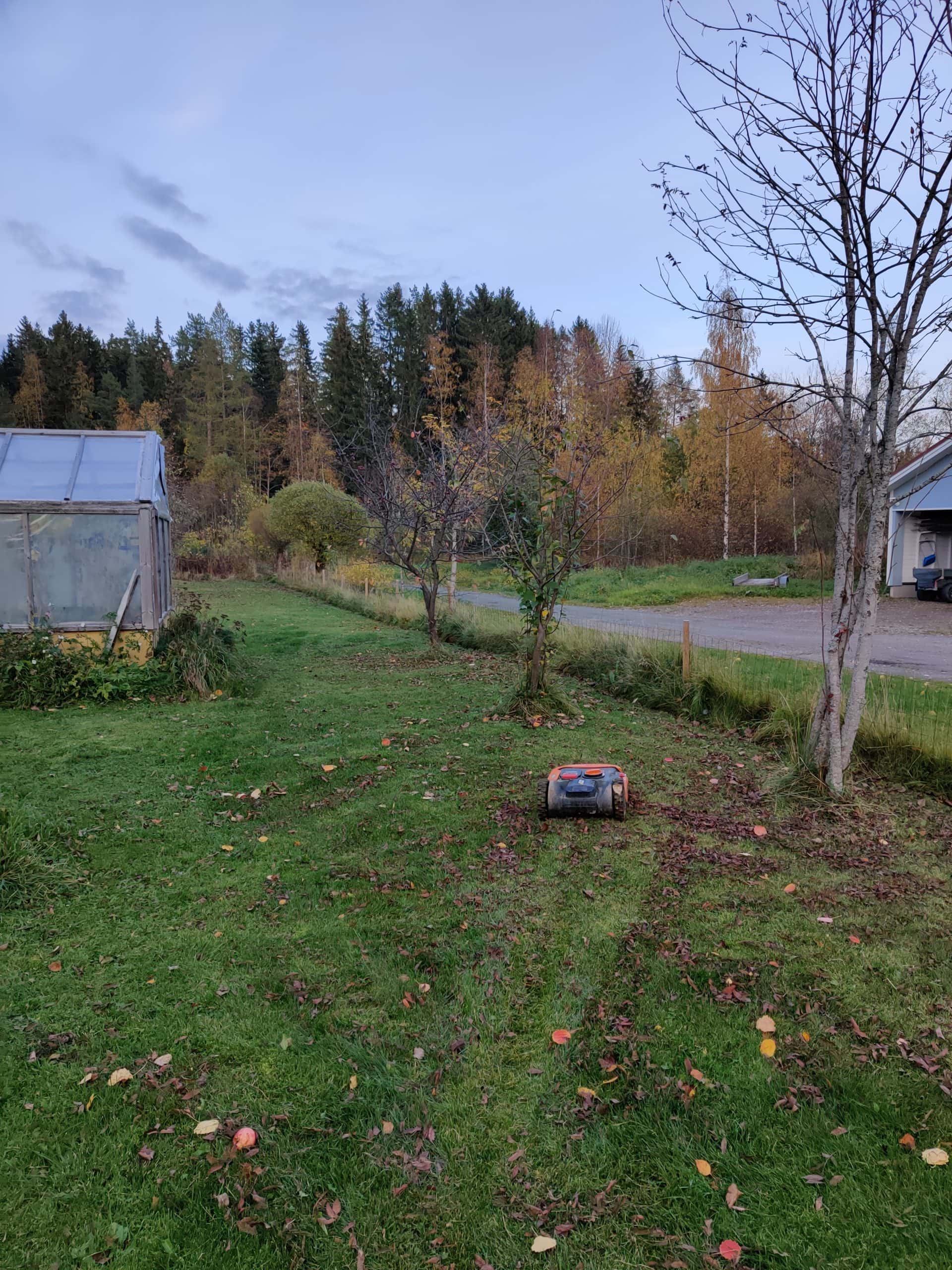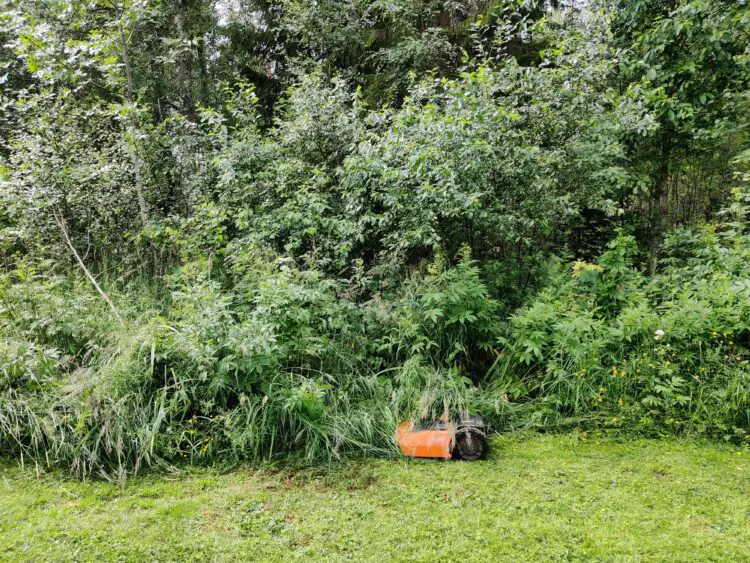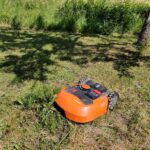This post was most recently updated on September 17th, 2022.
9 min read.This article is my attempt at documenting my experiences with Worx Landroid L2000. It’s a phenomenal little helper in your garden, but it will run into issues – and it will make your work a bit in order to get it to run efficiently!
This article contains all of the gotchas I’ve run into so far, wrapped in a handy FAQ format for your convenience (and mine, to be fair – I’ll be back to consult my notes later)!
Even though my robots are Landroids, quite a few of the points should apply to a lot of other robot lawnmower models.
FAQ
While my experiences come from 2 Worx Landroids, I suspect most of these apply to any low to mid-high-range autonomous mowers out there. The cream of the crop will probably behave differently, so if you’re buying one of the more expensive Husqvarnas, you’ll probably need to learn to live with your decisions without my help.
I have 2 Worx Landroids, model WR155E (or “L 2000”, the largest one they have). I have written at length about my experiences with the model here: http://koskila.net/worx-landroid-l2000-wr155e-review/
This probably depends on a lot of things, but the thickest my Landroid L 2000 has been able to cut, was about a centimeter in diameter.
That’s roughly 100 mickeys, 4.5 potrzebies or 2/5 of an inch, for those of you preferring imperial units.
It’s… A lot. Far more than I expected.
But generally speaking, you shouldn’t expect a robot to do more than what a weed whacker can do. Cutting thick wooden things will have a detrimental effect on your robot’s blades really quickly!
I’ve mentioned this before, but at least my Landroid manages hills and slopes well. However, there’s a couple of things you need to do in order to avoid issues.
If your grass is already tall, your robot might get stuck when trying to go uphill. In case the hill is close to the border of your lawn, the robot might (quite comically) just slide off the lot and freeze. These, and all other problems, are made worse when it’s wet outside!
And obviously, different devices will have different maximum grades they can navigate. Some AWD models claim they can do over 40 degrees!
There shouldn’t exactly be a limit – but at some point, the base will run out of juice providing the electric current for the wire, especially with many connectors.
If you buy high-quality connectors, you should be good.
Theoretically, any adapter that’ll let you join 2 cables should do. For whatever reason, most autonomous lawnmowers seem to come with Scotchlock 314 -typed splices adapter… Which shouldn’t be required. But since it’s what the manufacturers seem to prefer, I used them.
Well, I used a generic version – the original ones cost 2-3 € each, so I ordered a bunch of genuine Chinese copies, and they work just as fine and were in fact easier to install. So that’s good.
The most expensive robots should. For the mid-high range (such as my robots, Worx Landroid L 2000), you typically get to only define a starting point, and the rest is up to the form of your lawn.
You might, for example, have multiple sectors or parts of your lawn connected by a “corridor” – a narrow strip of lawn, where the boundary wire doesn’t quite connect but rather lets the robot through. That way you might want to define the first part of your lawn as Zone 1, and after your robot has followed the boundary wire to the second part, you could define that as Zone 2.
Unfortunately, most mid-high-range robots also come with some smart algorithms for traversing corridors. My Landroid is exceptionally good at escaping one sector of my lawn since I have a corridor that’s about 50 cm wide (that’s about 1/9 of the height of a double-decker bus for you imperialists out there!) – and it’s easily able to slip through.
I don’t like cutting grass in general, but I especially dislike it when it rains! But a robot doesn’t really care.
A lot of the robot lawn mowers on the market now are perfectly able to cut damp grass and don’t really mind getting wet, as far as they don’t get stuck in the mud!
But there are some caveats – depending on the model, the robot’s likelihood of getting stuck or obstructed will either increase or skyrocket when the conditions get worse. And the end result might not be as clean as it would be otherwise.
On separate sectors, yes, but if they share a border, you’ll run into weirdnesses.
At least with Landroids, the boundary cable only has electricity running through it when the robot is out and about. This means, that whenever it’s at home, the boundary cable is invisible to other robots out there.
This is primarily a good thing.
If you have your Landroids running at the same, you might experience one of 2 sorts of interference whenever they reach the boundary with 2 adjacent cables for different bases:
1) Your Landroid might sense both cables but realize they’re close enough to be crossed. Now you have 2 Landroids mowing an area where you should only have one, and when either one of them gets tired and goes home, the other one will wander off and possibly never be found again.
2) Your Landroid might sense both cables but be unsure why their frequencies don’t quite match. The poor little robot will stay confused until it runs out of battery, or the other robot goes home and the other boundary wire turns off.
Your robot might also just act normal – this is the case if the wires are far enough (20-something-plus cm) from one another.
Use pressurized air, and if need be, a brush or towel.
Don’t use a garden hose, and don’t even think about using a pressure washer.
I think all of the “new” (primary color orange) Landroid models use the same blades – small, razor-blade looking things. They usually come with just one hole, but replacement blades with 2 holes will work just as fine – since they’ll mostly get dull from the “far end”, you can actually get more life out of your blades by flipping them, if they have 2 holes.
And of course, you can always sharpen them again – it seems to me that just a few sets of blades will take you long way if you’re ok with occasionally sharpening old blades up.
Be sure to change the screws to new ones every time you change blades, though, as they wear out first!
There are plenty of options online for getting replacement blades, but 2 solid options are AliExpress and Amazon.
A good example of blades with just 1 hole would be these: https://s.click.aliexpress.com/e/_DDw635N
And with 2 holes:
https://s.click.aliexpress.com/e/_DeclH8x
Or if you prefer using Amazon:
https://amzn.to/3eVgDgr or https://amzn.to/3acmhZz
(To my experience Amazon is usually a bit more expensive than AliExpress, but far faster)
The message about low battery looks something like this:
! LOW BATTERY!
CANNOT START
But it’s actually misleading. You can send the Landroid home by pressing the Home/Charge -button, and then “OK” once or twice.
An added bonus is that your Landroid will actually have the blades running when sent home this way.
Worx Landroids have a great feature called border trim, edge cut, edge trim, border cut, or boundary cut (or whatever it’s called – it has multiple names in the documentation and the app!) As the name implies, the robot will simply follow the wire to cut the edges of the lawn.
This not only makes the lawn look good but is also imperative to ensure the little robots get home after their shift!
However, you can only schedule a run like this to happen once a day, and neither the app, the API, or the device itself has a way to command an edge trim.
There’s a workaround, though:
Send your Landroid to work, then STOP it, direct it towards the boundary, and hit the Home/Charge button once, and “OK” once (or occasionally twice).
Your Landroid will head to the boundary, then follow it home with blades running.
Unfortunately, I’d keep puppies as far from the robots as I can. While the mowers are relatively good at recognizing objects and either bumping into them softly or avoiding them altogether, you should not trust this.
Have your robots mow your lawn overnight and teach your puppies to stay away from it, just in case.
And don’t attach lasers to an autonomous robot with artificial intelligence. It’s not smart.
I’m guessing they haven’t, but I’m also a bit worried. At the time of writing (06/2022) the last software update came some time in September last year. And since software is rarely ever finished, I’d like to see more updates for sure.
That said, the firmware is pretty good. A lot of earlier quirks (like the robot lawn mower occasionally leaving its lot for the neighboring robot’s, or difficulties figuring out which way the border is) have been ironed out.
The mobile app (for Android) has gotten its last update in May 2022, but it’s still a bit cumbersome and not the most stable piece of software I’ve ever encountered.
All said, Worx might simply think the mowers are at a good place. And they’re still actively sold.
First of all, make sure you’re exposing 2.4GHz WiFi frequency for your robots, as that’s what they’re using! But additionally, it seems like whatever network card these devices are using, is pretty aggressive in entering power-saving mode – and it just drops off the network.
If the robots are on the fringe of your network, opening the app and trying to update the status of your robot might not work – Landroid Cloud pinging your robot simply doesn’t get through. However, it seems like having a device constantly maintaining the connection to the robots will counter this issue.
For me, that device would be Home Assistant, but you’d probably be fine just having the Landroid app in a smartphone without battery-saving features enabled.
No. Most likely, it’ll shred some of the leaves just fine, but largely just spread them around a bit.
See below for an example:
This is likely a symptom of your base station not getting enough juice from the power supply.
This can lead to your lot’s border wire not having electric current, which will – understandably – confuse your lawn mower. Additionally, the little robot might not even get charged.
You can measure the charger’s output with a multimeter to see if it’s performing up-to-spec, but in my case I’ve found 2 ways to fix the issue.
1) Have you tried turning it off and on again?
I’m not even kidding, simply cutting the power from the base station has helped a couple of times.
2) Let the power supply cool down!
The power supply / charger is a black box. If you leave it in the sun, it’ll heat up quite a lot.
Try letting it cool down in the shade – might do the trick!
3) Replace the power supply.
You can always order a new one – genuine items go for 100+€, but you can find copies starting from 20€.
Yes.
Not one maintained by Worx, however, but some enthusiastic hobbyists. It’s a solid implementation, but dependent on Worx’s Landroid cloud. This integration can be found here:
https://github.com/Barma-lej/halandroid
There’s an unmaintained, official integration for older models as well.
Puns aside, I’d vote for “yes”. The cutting result is far superior to anything I could do with a tractor or a traditional lawnmower.
I never thought I’d look at my lawn and go “Boy, is that a good-looking lawn” or “I can’t believe how proud I am of the grass.” This robot is making me turn middle class as we speak. And maybe also making me middle-aged :)
The cutting result is really, really clean after your robots have been able to do their magic for a while.
This list is unfinished for sure. But it’s all I had for now! Whenever I find something new, I’ll be sure to update it.
References
- Imperial units (I couldn’t remember what’s smaller than an inch, so I had to look them up):
- My review of Worx Landroid L 2000 (WR 155E) – the robot most of my experience comes from
(Purchasing something through the Amazon/AliExpress links supports my blog at no extra cost to you. Thank you!)

